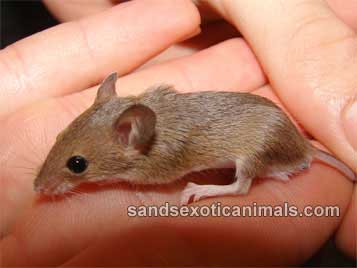
Origin:
Pygmy mice are found throughout Africa, south of the Sahara desert.Description:
The pygmy mouse has a brownish red coat with a white underbelly. The body of an adult is approximately 2 to 3 inches in length with a tail of 1 to 2.5 inches.Feeding:
Pygmy mice have a high rate of metabolism. A good diet consists of a combination of seeds, nuts, and fruits. You should give them parakeet or finch seed every day. At night you can offer them in a separate bowl a little bit of sliced fruits and vegetables. The fruits and vegetables can be fresh, frozen, dried or canned. Sunflower seeds can be added to their diet. Rodent block can also be used for a source of protein. Try to offer a variety of these items since all pygmy mice don't have the same preferences. Monkey biscuits can also be given as a treat once or twice a week. Provide fresh water in a water bottle daily. You can use a water bowl but it is best to place several small rocks in the bowl so if they fall in, they can get out.Housing:
Pygmy mice should be housed in a 5 gallon (or larger) aquarium. A heavy screen top is the best cover. Wood shavings or aspen bedding provide a suitable bedding material and all types of wood except cedar are acceptable. Pygmy mice can exercise inside the aquarium and love to play. An exercise wheel should be added to their habitat. Pygmy mice like to crawl through pieces of PVC pipe or toilet paper rolls. Branches and ladders can be spread around so they can climb from one to the other. Pygmy mice cannot tolerate temperatures below 60 degrees Fahrenheit.Miscellaneous:
You must be careful when handling them. They can jump straight up out of a 10 gallon aquarium.Longevity:
Up to 3 years in captivity
Compliments of:
S & S Exotic Animals, Inc., 1711 Connorvale, Houston, TX 77039 (281) 590-0426
http://www.sandsexoticanimals.com
